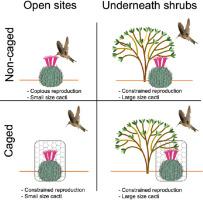Basic and Applied Ecology ( IF 3.8 ) Pub Date : 2021-05-08 , DOI: 10.1016/j.baae.2021.04.013 Arón Cádiz-Véliz , Franco Verdessi , Gastón O. Carvallo

|
Shrubs establish microenvironments under their canopies that can favor the growth of other plants. However, the shrub canopy could impede pollination by reducing the number of pollinator visits to sheltered plants, resulting in pollen limitation and decreased reproductive output. We assessed whether the presence of a nurse shrub species (Flourensia thurifera) alters the reproductive output of a sheltered cactus (Eriosyce coimasensis) via the restriction of access by the giant hummingbird (Patagona gigas) to E. coimasensis flowers. During two consecutive years (2018 – 2019), we excluded hummingbirds from individual cacti (using cages) and studied fruit set and seed production in two microhabitats: underneath shrubs and in open sites. In addition, we compared the reproductive mode of E. coimasensis in the two microhabitats. We observed that shrubs limit the reproduction of E. coimasensis, which strongly depends on P. gigas for seed production. Plants in open sites produced 80% more fruit and 76% more seeds than those growing underneath shrubs. The reproduction of caged individuals was low and similar to those growing beneath shrubs. In addition, plants underneath shrubs, but not in open sites, may suffer pollen limitation. Our results offer novel insights into plant-plant interactions and suggest potential trade-offs for sheltered cacti between the mild microclimatic conditions under the canopy, that could lead to larger plants and pollinator preclusion, which decreases the reproductive performance of sheltered plants.
中文翻译:

灌木冠层基质通过授粉媒介排斥降低了庇护植物的繁殖产量
灌木在树冠下建立微环境,有利于其他植物的生长。但是,灌木冠层可以通过减少传粉者对避难植物的探访次数来阻止授粉,从而限制花粉并降低繁殖产量。我们通过限制巨型蜂鸟(Patagona gigas)进入大肠杆菌(E. coimasensis)花的途径,评估是否存在护士灌木树种(Flourensia thurifera)改变了庇护仙人掌(Eriosyce coimasensis)的繁殖输出。在连续两年(2018年至2019年)中,我们从单独的仙人掌中(使用网箱)排除了蜂鸟,并研究了灌木和地下两处微型栖息地的坐果和种子生产。此外,我们比较了两种微生境中大肠杆菌的繁殖方式。我们观察到,灌木限制再现E. coimasensis,这在很大程度上取决于P.牡蛎用于种子生产。与灌木下生长的植物相比,空地上的植物产生的果实多80%,种子多76%。关在笼中的个体的繁殖率很低,与灌木丛中的繁殖者相似。此外,灌木下面但不在空旷地带的植物可能受花粉限制。我们的研究结果为植物与植物之间的相互作用提供了新颖的见解,并提出了在冠层下温和的微气候条件之间庇护仙人掌的潜在折衷方案,这可能导致更大的植物和授粉媒介被排斥,从而降低庇护植物的繁殖性能。


























 京公网安备 11010802027423号
京公网安备 11010802027423号